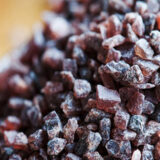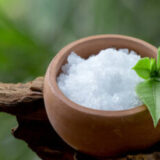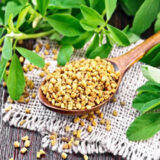Holy Basil: Its Type, Healing Properties, Uses And Precautions
Holy basil and Tulsi are two names used interchangeably to refer to the same plant, scientifically known as Ocimum tenuiflorum or Ocimum sanctum. Holy basil is the English name, while Tulsi is the Sanskrit name commonly used in India.
In Hinduism, Tulsi is considered a sacred plant and is often found planted in homes and temples. It is highly revered for its spiritual significance and is believed to be the earthly manifestation of the goddess Tulsi/Vrinda.
From a medicinal standpoint, holy basil or Tulsi is valued for its therapeutic properties and has been used in Ayurvedic medicine for centuries. It is known for its adaptogenic, antioxidant, anti-inflammatory, and immune-supporting properties. Holy basil is used in various forms, including leaves, extracts, essential oils, and herbal preparations, to promote overall well-being and address specific health concerns.
Whether you refer to it as holy basil or Tulsi, this plant is held in high regard and widely utilized for its potential health benefits, culinary uses, and spiritual significance.
Holy Basil Tulsi Types
There are several types of holy basil, also known as Tulsi, each with its own unique characteristics and properties. Here are a few common types of holy basil:
1. Krishna Tulsi (Ocimum tenuiflorum): Krishna Tulsi has dark purple or almost black leaves and a slightly spicy flavor. It is often considered the most potent variety of holy basil and is highly valued for its medicinal properties. Krishna Tulsi is believed to have a balancing effect on the mind and body and is often used to promote respiratory health.
2. Rama Tulsi (Ocimum tenuiflorum): Rama Tulsi has green leaves and a milder, sweeter flavor compared to other varieties. It is commonly used in Ayurvedic medicine for its calming and balancing properties. Rama Tulsi is often used to support overall well-being and promote a sense of tranquility.
3. Vana Tulsi (Ocimum gratissimum): Vana Tulsi, also known as wild or forest tulsi, has light green leaves and a strong, refreshing aroma. It is considered more wild and robust compared to other types of holy basil. Vana Tulsi is often used for its antimicrobial properties and is believed to support respiratory health and immune function.
4. Kapoor Tulsi (Ocimum sanctum): Kapoor Tulsi has green leaves with a unique camphor-like aroma. It is commonly used in religious ceremonies in India and is highly revered for its spiritual and purifying qualities. Kapoor Tulsi is also known for its cooling properties and is used to support digestive health.
5. Amrita Tulsi (Ocimum tenuiflorum x Ocimum gratissimum): Amrita Tulsi is a hybrid variety that combines the characteristics of Krishna Tulsi and Vana Tulsi. It has green leaves with purple veins and is known for its adaptogenic properties. Amrita Tulsi is often used to combat stress, promote mental clarity, and support overall well-being.
Each variety may have slightly different chemical compositions and medicinal properties, although they all share common benefits associated with holy basil as a whole.
Depending on your needs and preferences, you can choose the type of holy basil that resonates with you or experiment with different varieties to explore their unique flavors and effects.
Healing Properties Of Holy Basil
Here are some potential healing properties associated with holy basil:
Adaptogenic properties: Holy basil is classified as an adaptogen, which means it may help the body adapt to stress and promote balance. It is believed to have a calming effect on the nervous system and can help reduce anxiety and stress.
Antioxidant activity: Holy basil contains compounds such as flavonoids and phenols, which have antioxidant properties. These antioxidants help neutralize harmful free radicals and protect the body’s cells from oxidative stress and damage.
Anti-inflammatory effects: Holy basil contains eugenol, a compound known for its anti-inflammatory properties. It may help reduce inflammation in the body and alleviate symptoms of inflammatory conditions such as arthritis.
Immune support: Holy basil is believed to have immune-enhancing properties. It may help strengthen the immune system and increase the body’s resistance to infections and diseases.
Antimicrobial activity: Holy basil has been traditionally used to combat various infections. Scientific studies have shown that it may possess antimicrobial properties and help inhibit the growth of certain bacteria, viruses, and fungi.
Respiratory health: Holy basil is often used to support respiratory health. It may help relieve symptoms of cough, cold, and respiratory infections. Holy basil leaves are sometimes brewed into a tea or used as an ingredient in herbal cough syrups.
Digestive support: Holy basil has been used to aid digestion and relieve digestive issues such as bloating, flatulence, and stomach cramps. It is believed to have carminative properties, which can help soothe the digestive tract.
Antidiabetic effects: Some studies suggest that holy basil may help regulate blood sugar levels. It may have a hypoglycemic effect and could potentially be beneficial for individuals with diabetes. However, further research is needed to confirm these effects.
It’s important to note that while holy basil has a long history of traditional use and shows promise in scientific studies, it should not be used as a substitute for professional medical advice. If you have any health concerns or are considering using holy basil for a specific condition, it’s best to consult with a healthcare practitioner familiar with herbal medicine or Ayurveda.
How To Uses of Holy Basil (Tulsi)?
Holy basil, or Tulsi, can be used in various ways to harness its potential benefits. Here are some common methods of using holy basil:
1. Tea: Holy basil leaves can be used to make a soothing herbal tea. Simply steep a handful of fresh or dried holy basil leaves in hot water for about 5 to 10 minutes. You can drink the tea as is or add a touch of honey or lemon for flavor.
2. Essential oil: Holy basil essential oil is available and can be used for aromatherapy or topical application. You can add a few drops of holy basil essential oil to a diffuser to create a calming atmosphere or mix it with a carrier oil (such as coconut oil) for topical use. Please note that essential oils are highly concentrated, so they should be used with caution and diluted appropriately.
3. Fresh leaves: Holy basil leaves can be consumed fresh. They have a slightly peppery and minty flavor. You can add them to salads, soups, stir-fries, or sandwiches for a unique taste and potential health benefits.
4. Herbal preparations: Holy basil is available in various herbal preparations, such as capsules, tinctures, and extracts. These forms provide a convenient way to incorporate holy basil into your daily routine, especially if fresh leaves are not readily available.
5. Skincare: Holy basil is sometimes used in natural skincare products due to its antioxidant and anti-inflammatory properties. You can find holy basil-infused creams, lotions, or face masks. It’s important to follow the manufacturer’s instructions when using such products.
6. Ayurvedic formulations: Holy basil is a key ingredient in many Ayurvedic formulations. It is often combined with other herbs to create tonics, powders, or herbal blends targeting specific health concerns. These formulations should be used under the guidance of an Ayurvedic practitioner.
7. Holy basil pesto: Holy basil leaves can be used to make a delicious pesto sauce. Blend fresh holy basil leaves with garlic, pine nuts or walnuts, Parmesan cheese (or a vegan alternative), olive oil, and a pinch of salt. Use the pesto as a spread on sandwiches, toss it with pasta, or use it as a flavorful topping for roasted vegetables.
8. Infused oil: You can infuse holy basil leaves in oil to create a fragrant and therapeutic oil. Place fresh holy basil leaves in a jar and cover them with a carrier oil such as olive oil or coconut oil. Let the mixture sit in a cool, dark place for a few weeks to allow the flavors and properties of the holy basil to infuse into the oil. Strain the leaves and use the infused oil for massage, as a moisturizer, or for scalp and hair treatments.
9. Holy basil bath: Add a handful of fresh holy basil leaves or a few drops of holy basil essential oil to your bathwater for a soothing and aromatic experience. Holy basil is believed to have a calming effect on the mind and body, promoting relaxation and relieving stress.
10. Herbal steam: Create a steam inhalation with holy basil to help clear the respiratory system and relax the senses. Boil water in a pot, add a handful of fresh holy basil leaves, and allow the steam to rise. Carefully lean over the pot, cover your head with a towel, and inhale the steam for a few minutes. This can be helpful for congestion, sinus issues, or simply as a calming ritual.
11. Holy basil mouthwash: Holy basil has antimicrobial properties and can be used as a natural mouthwash. Boil water and add a handful of fresh holy basil leaves. Let the mixture cool, strain it, and use it as a mouthwash to freshen breath and promote oral health.
12. Holy basil poultice: Crush fresh holy basil leaves and apply them directly to minor skin irritations, insect bites, or cuts to help soothe inflammation and promote healing. You can also use a mortar and pestle to create a paste with the leaves and apply it to the affected area.
Remember to perform a patch test before using any topical preparations to ensure you don’t have any allergic reactions. Holy basil is generally considered safe for most people when consumed in moderate amounts or used topically, but it’s always wise to consult a healthcare professional or herbalist for personalized advice.
Precautions
While holy basil, or Tulsi, is generally considered safe for most people when consumed in moderate amounts, there are a few precautions to keep in mind:
1. Allergies: Some individuals may be allergic to holy basil. If you have known allergies to plants in the Lamiaceae family (such as mint, basil, or lavender), it’s best to exercise caution when using holy basil and monitor for any adverse reactions.
2. Pregnancy and breastfeeding: There is limited research on the safety of holy basil during pregnancy and breastfeeding. It’s advisable to consult with a healthcare professional before using holy basil if you are pregnant, planning to become pregnant, or breastfeeding.
3. Drug interactions: Holy basil may interact with certain medications, including anticoagulants (blood thinners), antihypertensive drugs (blood pressure medications), and diabetes medications. If you are taking any medications, it’s important to consult with your healthcare provider before using holy basil to avoid potential interactions.
4. Surgery: Holy basil may have antiplatelet and hypotensive effects, which could potentially interfere with blood clotting and blood pressure control during and after surgery. If you have a scheduled surgery, it’s crucial to inform your healthcare provider about your use of holy basil to ensure a safe perioperative period.
5. Digestive sensitivity: Some individuals may experience gastrointestinal discomfort, such as stomach upset or acid reflux, when consuming holy basil. If you have a sensitive stomach or a history of digestive issues, start with a small amount of holy basil and monitor your body’s response.
It’s important to note that while holy basil has a long history of traditional use and shows promise in scientific research, it should not be used as a substitute for professional medical advice. If you have any specific health concerns or are considering using holy basil for a particular condition, it’s best to consult with a healthcare practitioner familiar with herbal medicine or Ayurveda. They can provide personalized guidance based on your individual circumstances and help ensure safe and appropriate usage.























